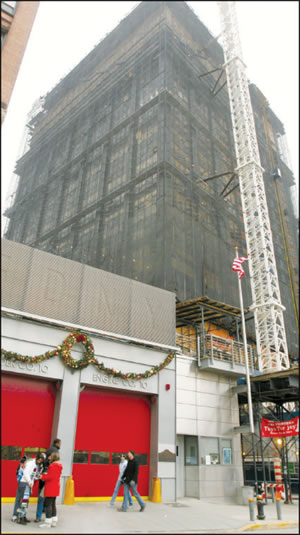By Julie Shapiro
Downtown Express file photo by Jefferson Siegel
The former Deutsche Bank building at the end of last year, several months after two firefighters were killed. It’s adjacent to the 10/10 firehouse and was one of the topics of dicsuion last week at a talk on urban demolitions as part of the Dept. of Buildings’ “Safety Week.”
With New Yorkers talking not about “the big construction accident,” but “the latest big construction accident,” Construction Safety Week never felt timelier.
Perhaps the person most aware of the city’s growing concern about construction safety is acting Buildings Commissioner Robert LiMandri. He stepped into the job when former Commissioner Patricia Lancaster resigned three weeks ago — after she disclosed that the Department of Buildings mistakenly approved the Upper East Side building where a crane collapse killed seven people.
Construction Safety Week has gotten more attention than usual this year, because it echoes the Buildings Department’s increasing focus on safety amid the disasters, LiMandri said.
“Development cannot take place at the expense of workers,” he told Downtown Express last week. “Every worker has the right to go home to their family at night. Everyone says construction is dangerous, but you can’t stop there — you have to say, ‘Yes, it’s dangerous, but you have to do it safely.”
To that end, the Buildings Department held a series of workshops throughout the city last week. On Wednesday, a seminar called “Safety First: Urban Demolitions” drew 50 construction workers, contractors, engineers and project managers. The location couldn’t have been more appropriate for discussing demolitions: a conference room in the new 7 World Trade Center, overlooking Fiterman Hall and the former Deutsche Bank building — two towers damaged on 9/11 and still awaiting demolition.
LiMandri opened the presentation by acknowledging that demolitions are dangerous. Last year, New York City saw seven major demolition accidents, which injured seven workers and killed three people — including the two firefighters who died in a fire at the Deutsche Bank building at 130 Liberty St. last August.
Demolitions also net more violations than other construction work, added Richard Mendelson, area director for the Occupational Safety and Health Administration’s Manhattan office.
Last year, OSHA did 45 site inspections of demolition work in the city. At 38 of those sites, inspectors saw enough problems to issue a total of 175 violations, including some at Deutsche. That’s an average of 3.9 violations per inspected demolition site, higher than OSHA’s average of 3.2 violations per general construction site.
The D.O.B. and OSHA spent much of Wednesday’s presentation detailing their respective construction codes, which differ slightly but do not conflict.
A new city construction code goes into effect July 1, and all demolition projects will automatically be subject to the new regulations. Some of the biggest changes in the new code relate to demolition, said Dan Eschenasy, who works in engineering and emergency operations for the D.O.B.
The new code creates stricter standards for what counts as a major demolition operation, requiring more regulatory approval. A major building, for example, will now be defined as 10 stories and up, rather than 15. In another change, contractors will soon have to list all equipment that is not handheld, which will give the Buildings Department a better idea of the scope of the project and how to regulate it.
“The idea is to bring more engineering into demolition,” Eschenasy said.
Engineers should weigh the existing stresses on the building before demolition even begins, and they should also predict the new stresses that demolition will add. As a building is deconstructed, it grows less resistant to wind, vibrations and shocks.
As Eschenasy said, “Structures were not built with demolition in mind.”
To ensure that demolition projects have qualified people overseeing them, the Buildings Department will begin certifying site safety coordinators next month.
The Fire Department also made a presentation, because firefighters are familiar with the dangers of demolitions, said Richard Tobin, assistant chief of fire prevention for F.D.N.Y.
Tobin showed photos of the Deutsche Bank fire, which occurred while workers were decontaminating and demolishing the building simultaneously. The decontamination work required that flammable materials be kept in the building and also required negative air pressure be maintained — conditions that increased the fire’s danger.
The building code has always required that contractors empty the building of flammable material before they demolish it. At the end of each work day, contractors are required to remove any combustible waste in excess of 15 cubic yards, Tobin said. But at 130 Liberty St, the Buildings Department, OSHA, the Environmental Protection Agency and others approved a plan that permitted combustible material related to the decontamination work while demolition proceeded on other floors.
D.O.B.’s LiMandri said it is generally safer to remove combustible materials before demolition work begins, but he did not comment on the original Deutsche plan. His spokesperson cited the criminal investigation into the fatal fire. The post-fire Deutsche plan prohibits demolition work until the decontamination is completed.
Tobin frequently mentioned regulations prohibiting workers from smoking on job sites. A worker’s cigarette is said to have started the fire at 130 Liberty.
Near the conclusion of his presentation, Tobin listed several of his friends who have been killed at construction sites over the years.
“When people play by the rules and follow the regulations, everyone goes home safe,” Tobin said. Gesturing to the contractors in the room, he added, “These are your people who are going to get hurt, not just us.”
The presentation was a review for many of the attendees, but a welcome one.
Manuel Reinoso, 35, who does demolition work for Seasons Industrial, said he was glad to see the Buildings Department’s focus on enforcing safety regulations.
“They are looking out for us,” he said after the presentation. “They’re not just making rules to make us work hard. They care about us, which is great. I’m very glad.”
Ben Versaci, with the New York City Demolition Contractors Association, was pleased to see the government agencies communicating and coordinating their efforts.
“It looks like the Fire Department and the Buildings Department are taking our information and putting it into practice,” he said.
As Eschenasy, of the D.O.B., explained the city’s detailed demolition rules, which often have exceptions or caveats, he reminded the audience that the D.O.B. doesn’t just add rules for the sake of adding rules.
“We did not [introduce] these requirements because we want to be stricter,” he said, showing pictures of fires, collapsed buildings and bodies being wheeled out on stretchers.
But at the end of his presentation, he struck a lighter tone.
“We’re trying to beat OSHA with more requirements,” Eschenasy said, “and I think we made it.”
Julie@DowntownExpress.com

































